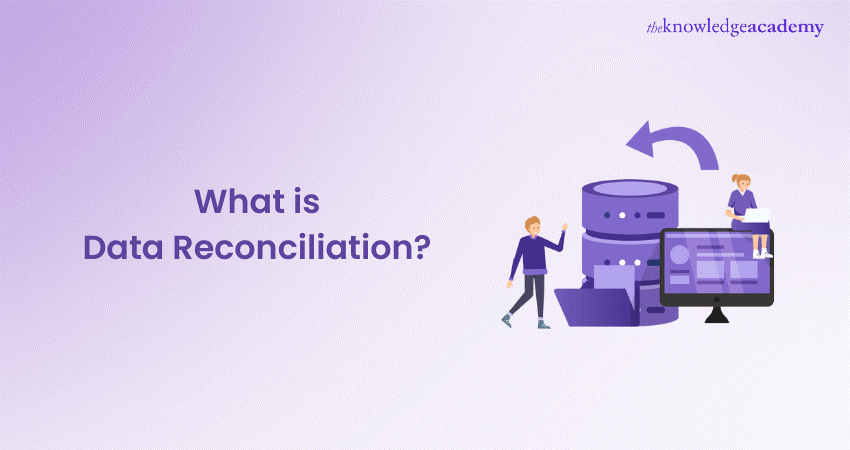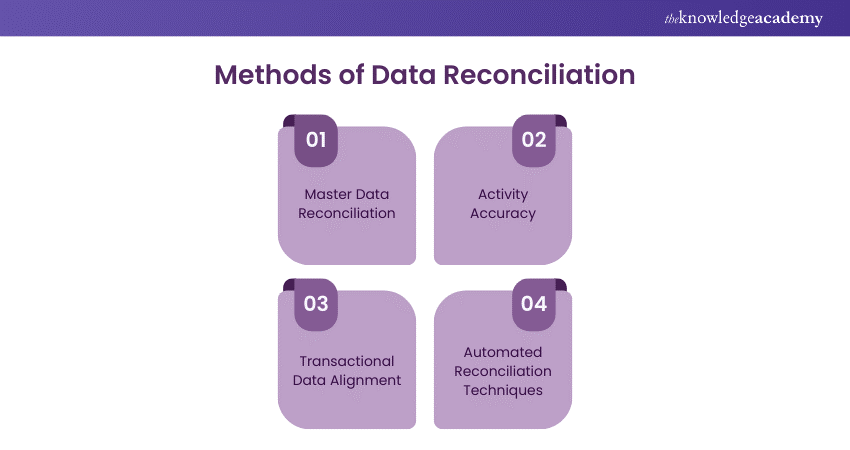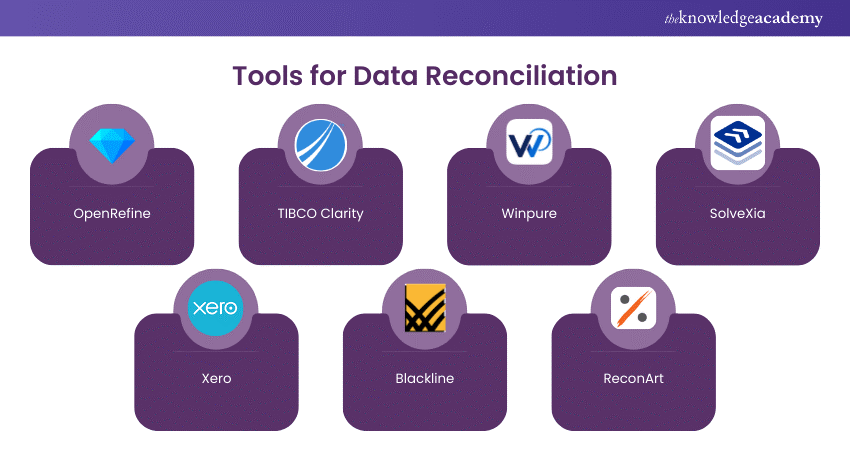We may not have the course you’re looking for. If you enquire or give us a call on 01344203999 and speak to our training experts, we may still be able to help with your training requirements.
We ensure quality, budget-alignment, and timely delivery by our expert instructors.

The data migration process can at times give birth to many issues. Problems such as run time failures, network dropouts or even broken transactions can corrupt data. These errors can lead to numerous serious issues. Here's exactly where Data Reconciliation comes into play. But many organisations are unaware of What is Data Reconciliation?
Data Reconciliation involves comparing multiple sets of data to identify and rectify discrepancies. Whether during data migration or routine business operations, this process ensures that data remains accurate and consistent.
Thus, it is crucial to learn about this process and eliminate data overlap. This blog will explore everything about What is Data Reconciliation, its evolution, methods and tools. So, read ahead to learn more!
Table of Contents
1) What is Data Reconciliation?
2) Evolution of Data Reconciliation
3) Importance of Data Reconciliation
4) Instances Requiring Data Reconciliation
5) Methods of Data Reconciliation
6) Challenges in Data Reconciliation
7) Tools for Data Reconciliation
8) Conclusion
What is Data Reconciliation?
Data Reconciliation is a critical process in the world of Data Management. It is essential for ensuring accuracy and consistency across different data sources. In basic terms, Data Reconciliation can be defined as a process of data verification during the migration process.
It compares data from two or more sources to identify discrepancies, resolve differences, and update records to reflect accurate and unified information. This process is crucial in industries where data integrity directly impacts decision-making, compliance, and operational efficiency.
Evolution of Data Reconciliation
The evolution of Data Reconciliation demonstrates the process of technology in Data Management. Initially, it was a labour-intensive and manual process. Earlier, it required a huge amount of human effort and was prone to errors.
However, as databases became more sophisticated and computing power increased, automated tools and algorithms began to take over. It significantly enhanced the speed, accuracy, and efficiency of Data Reconciliation processes. Today, advanced analytics, Machine Learning algorithms, and Artificial Intelligence play a significant role in automating and optimising reconciliation tasks.
Learn and gain expertise in handling massive databases with our Big Data and Analytics Training – join today!
Importance of Data Reconciliation
The main role of Data Reconciliation is to support Data Management and Data Utilisation practices of modern days in terms of effectiveness. It is the crucial process for assuring the accuracy, consistency, and effectiveness of statistics among different databases and platforms. It enhances the capacity for policy formulation and execution planning. Listed here are key points highlighting importance:
1) Enhances Data Accuracy and Quality: By identifying and resolving discrepancies in data from different sources, Data Reconciliation improves the overall quality and accuracy of the information that organisations rely on for decision-making.
2) Supports Compliance and Reporting: Accurate data is essential for regulatory compliance and accurate reporting. Data Reconciliation ensures that organisations meet legal standards and report accurately on their operations, financials, and customer interactions.
3) Facilitates Better Decision-making: High-quality, reconciled data provides a solid foundation for Business Intelligence and analytics. Organisations can make more informed decisions when they are confident in the accuracy and completeness of their data.
4) Improves Operational Efficiency: Resolving data inconsistencies and errors through reconciliation reduces operational bottlenecks and inefficiencies. It ensures that systems and processes run smoothly, with less downtime and fewer errors.
5) Minimises Risk Factor: Inaccurate data can lead to strategic missteps, financial losses, and damaged reputations. Data Reconciliation mitigates these risks by ensuring that critical data is accurate and consistent across all systems.
6) Enhances Customer Satisfaction: Accurate, reconciled data enables organisations to understand their customers and offer more personalised and efficient services. This leads to enhanced customer satisfaction and loyalty.
7) Facilitates System Integrations and Migrations: During system upgrades, migrations, or integrations, Data Reconciliation ensures that data remains consistent and accurate across old and new systems, preventing data loss or corruption.
8) Reduces Costs: By identifying and correcting errors early, Data Reconciliation can help avoid the higher costs associated with rectifying issues later in the data lifecycle. This includes costs related to erroneous decision-making, compliance penalties, and operational inefficiencies.
Instances Requiring Data Reconciliation
Now that you know What is Data Reconciliation, you must also remember that it is necessary in numerous situations. This includes but is not limited to the following listed below:
Ensuring Accuracy During Data Migrations
It is a major part of the data migration journey which includes transferring sensitive information from the legacy system to a new one. Through this process, Data Reconciliation makes certain that the data inputs from the new system fit in with the data in the source system.
Through merging and harmonisation of databases, this management enables the finding and ironing out of the differences. This is the most important to secure data stability, data integrity, and accuracy during the migration process.
Assessing data quality in regular business operations
In regular business operations, Data Reconciliation helps in maintaining data quality and consistency. Whether it’s customer contact details, production data, or order information, regular inspection ensures that the data has been reliable. By reconciling data across multiple platforms or systems, businesses can achieve a single customer view, improve operational efficiency, and make informed decisions.
Addressing Complexities in financial services
Financial institutions, including e-commerce, logistics, healthcare, insurance companies, banks, and investment firms, rely heavily on accurate data. Data Reconciliation is critical for the following:
1) Risk Management: Detecting fraud or potential errors.
2) Compliance: Ensuring accuracy in financial reporting.
3) Investment Data Reconciliation: Maintaining data integrity for investment portfolios.
Methods of Data Reconciliation
Data Reconciliation is an important process in maintaining data accuracy and consistency. Let’s explore some essential methods for effective reconciliation of data:

1) Master Data Reconciliation
Master data, such as product details, customer information or employee records, serves as a reference point for other datasets. Reconciling master data involves verifying its accuracy across various systems. Key steps include identifying discrepancies, resolving conflicts, and updating the master dataset.
2) Activity Accuracy
Activity-based reconciliation focuses on tracking events or transactions. For instance, in financial systems, reconciling bank statements with transaction records ensures that all deposits, withdrawals, and fees are accurately recorded. Regular audits and automated checks help maintain activity accuracy.
3) Transactional Data Alignment
Transactional Data Reconciliation involves comparing generated data during specific processes. For example, reconciling inventory records with sales orders ensures that stock levels match customer demand. Timely adjustments prevent stockouts or excess inventory.
4) Automated Reconciliation Techniques
Leveraging technology and automated reconciliation streamlines the process. Techniques include the following:
1) Matching Algorithms: These algorithms identify similarities between datasets, flagging discrepancies for further investigation.
2) Exception Reports: Automated systems generate reports highlighting inconsistencies, enabling quick resolution.
3) Data Validation Rules: Implementing predefined rules ensures data integrity and reduces manual effort.
Challenges in Data Reconciliation
The process of Data Reconciliation consists in comparing data from different sources, indicating differences, and settling them for the purpose of data security. However, the following challenges can complicate reconciliation efforts:
1) Lack of Data Consistency
Data compatibility problems come about when different systems or departments within an organisation adopt a variety of formats, standards, or representations for data that is of similar type. This absence of uniformity creates a problem to match and reconcile data properly and followed with the possibilities of erroneous reporting or analysis.
2) Human Errors
Human intervention in data entry, processing, or management often leads to mistakes. These can range from simple typos to more significant errors like duplications or omissions. Human errors not only make Data Reconciliation more challenging but can also have cascading effects on data quality overall.
3) Obsolete Systems
Many organisations rely on outdated systems for data storage and processing. These legacy systems might not be compatible with newer technologies, making it difficult to extract, transform, and load data for reconciliation purposes.
4) Managing Large Volumes of data
With the exponential growth of data, organisations face challenges in handling vast volumes of information efficiently. The sheer scale of data can overwhelm traditional Data Reconciliation tools and processes, leading to bottlenecks and delays.
5) System Integration Issues
Organisations often use a variety of software applications and databases, each designed for specific purposes. Integrating these disparate systems to achieve seamless data flow for reconciliation purposes is a complex task that requires significant effort and expertise.
6) Temporal Disparities
Differences in the timing of data capture, processing, and reporting can lead to discrepancies. For example, if two systems update data at different times, reconciling this data can be challenging without accounting for these temporal disparities.
7) Development Costs and Complexities
Developing or purchasing software solutions for Data Reconciliation can be costly. Furthermore, the complexity of implementing these solutions, especially in a way that is tailored to an organisation's specific needs, adds to the challenge.
Tools for Data Reconciliation
Despite all kinds of challenges, several tools and solutions have been developed to aid in the process of Data Reconciliation. Let's explore the tools listed below:

1) OpenRefine
OpenRefine is an open-source tool designed to work with clustered data. It allows users to clean, transform, and extend data with web services and external data. OpenRefine's capabilities make it a valuable tool for reconciling differences in data from various sources.
2) TIBCO Clarity
TIBCO Clarity is a powerful tool that helps organisations cleanse, standardise, and validate data. It supports Data Reconciliation by ensuring that data from different sources is accurate and consistent before it is merged or analysed.
3) Winpure
Winpure is a matching and data cleansing software that offers numerous features to improve data quality. It helps in identifying and removing duplicates, correcting errors, and standardising data formats, which are crucial steps in the Data Reconciliation process.
Gain proficiency in data science and analytical skills with our Data Science Courses – sign up now!
Conclusion
We hope that after reading this blog, you are now aware of What is Data Reconciliation. It is not only about numbers, but also about ensuring informed decision-making, compliance, and operational efficiency. By embracing the right tools and methodologies, organisations can maintain data integrity and drive success.
Gain in-depth knowledge about various advanced analytical theories and methods with our Big Data Analytics and Data Science Integration Course – join now!
Frequently Asked Questions
What is the Objective of Data Reconciliation?

The objective of Data Reconciliation is to ensure accuracy and consistency across data sources by identifying and correcting any discrepancies, making sure data aligns properly throughout the system for reliable insights and decision-making.
What is Data Reconciliation in ETL Testing?

In ETL Testing, Data Reconciliation ensures that data extracted, transformed, and loaded matches across sources and target systems. It verifies that data integrity is maintained, with accurate data flow from source to destination for trustworthy analytics.
What are the Other Resources and Offers Provided by The Knowledge Academy?

The Knowledge Academy takes global learning to new heights, offering over 3,000 online courses across 490+ locations in 190+ countries. This expansive reach ensures accessibility and convenience for learners worldwide.
Alongside our diverse Online Course Catalogue, encompassing 19 major categories, we go the extra mile by providing a plethora of free educational Online Resources like News updates, Blogs, videos, webinars, and interview questions. Tailoring learning experiences further, professionals can maximise value with customisable Course Bundles of TKA.
What is The Knowledge Pass, and How Does it Work?

The Knowledge Academy’s Knowledge Pass, a prepaid voucher, adds another layer of flexibility, allowing course bookings over a 12-month period. Join us on a journey where education knows no bounds.
What are the Related Courses and Blogs Provided by The Knowledge Academy?

The Knowledge Academy offers various Big Data and Analytics Training, including Advanced Data Analytics Certification, Certified Artificial Intelligence For Data Analysts Training, and Data Science Analytics Courses. These courses cater to different skill levels, providing comprehensive insights into Data Preprocessing in Machine Learning
Our Data, Analytics and AI Blogs cover a range of topics related to leadership approach, offering valuable resources, best practices, and industry insights. Whether you are a beginner or looking to advance your leadership skills, The Knowledge Academy's diverse courses and informative blogs have you covered.
Upcoming Data, Analytics & AI Resources Batches & Dates
Date
 Data Science Analytics
Data Science Analytics
Fri 25th Apr 2025
Fri 20th Jun 2025
Fri 22nd Aug 2025
Fri 17th Oct 2025
Fri 19th Dec 2025






 Top Rated Course
Top Rated Course



 If you wish to make any changes to your course, please
If you wish to make any changes to your course, please


